News and Analysis on scarce coins, markets, and coin collecting #79
A Weekly Column by Greg Reynolds
The topic here is ideas for beginning and intermediate level collectors who wish to complete or nearly complete a set of one series of silver quarters. Information and advice are provided, especially for collectors who are would like to collect silver quarters without spending a fortune.
Those who do not understand the notion of completing a set of quarters may wish to read an earlier column on Basics for Beginners. (As always, clickable links are in blue.) General collecting advice is provided therein and in another relevant column, advice for beginning and intermediate collectors of U.S. coins. Last week, I wrote about assembling sets of silver dimes or half dollars.
I. Types of Quarters
U.S. Quarters were first minted in 1796 and continue to be minted in the present. Indeed, the U.S. Mint will probably produce quarter dollars for the foreseeable future.
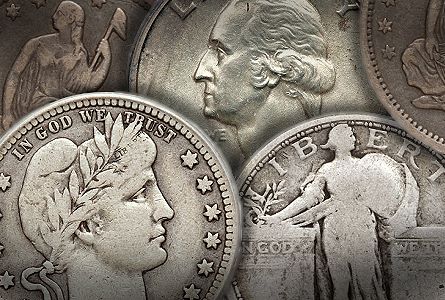 As this discussion is geared towards beginning or intermediate level collectors, including those on tight budgets, I am not mentioning Proofs here, although I very much like them. I will devote a separate column to Proof Quarters. The topic here is business strike silver quarters, which typically are coins that were produced for circulation.
As this discussion is geared towards beginning or intermediate level collectors, including those on tight budgets, I am not mentioning Proofs here, although I very much like them. I will devote a separate column to Proof Quarters. The topic here is business strike silver quarters, which typically are coins that were produced for circulation.
U.S. Quarter Dollars were never 100% silver. They have always contained some copper and traces of other metals have unintentionally found their way into or onto planchets (prepared blanks) during the production process. Quarters dating from 1796 to 1836 consist of about 89.24% silver. Quarters struck from 1837 to 1964 are 90% silver, more or less.
Some 1976-S non-Proof, Bicentennial quarters were struck in a silver alloy. These are a different topic.
Kris Oyster is “an advocate of collecting by type, one coin of each [design] type. For not too much money, beginners could find nice Very Fine to AU Liberty Seated, Barber, Standing Liberty and Washington Quarters. For example, you could probably buy an 1899 Barber Quarter in AU for $125. Someone who can’t afford that could buy a 19th century Barber Quarter in Good condition for $10. A type set of silver quarters from 1838 to 1964 is not too expensive. Also, you could probably buy a VF Capped Bust Quarter for $150, or one in Good condition for less than $50.” Oyster is a managing director at DGSE.
In 1796 only, quarters featured a Draped Bust obverse (front) design and a so-called ‘Small Eagle’ reverse (back) design. There are no quarters dated from 1797 to 1803. Two Reales (“two bits”) coins of the Spanish Empire then circulated widely in North America and served as quarter dollars. Quarters dated from 1804 to 1807 had the same Draped Bust obverse along with a Heraldic Eagle reverse design, which is sometimes called the ‘Large Eagle’ design.
Quarters were not minted again until 1815. Capped Bust Quarters, with the Latin phrase ‘E. Pluribus Unum’ on the reverse, were struck from 1815 until 1828. This phrase is difficult to translate, ‘From Many Emerged One,’ a tribute to the independence, growth and unification of the United States. People in the original States had different cultures, political philosophies and lifestyles. It was extremely difficult to turn a loose confederation into a true nation, and to compose a constitution on which most influential citizens could agree.
From 1831 to 1838, quarters had a slightly different Capped Bust obverse design and a reverse design that lacked this Latin phrase, E. Pluribus Unum, which is sometimes called a ‘motto.’ There are other differences relating to the Capped Bust Quarters of 1815 to 1828 and those dating from 1831 to 1838. These are clearly two different types.
Liberty Seated Quarters were minted from 1838 to 1891. It is generally agreed that there are six different types or subtypes, though (1) No Drapery, 1838-40; (2) ‘No Motto’ 1840-53, 1856-65; (3) Arrows & Rays 1853 only; (4) Arrows (without rays) 1854-55; (5) ‘With Motto’ – In God We Trust, 1866-73, 1875-91; (6) Arrows & Motto, 1873-74.
Barber Quarters were minted from 1892 to 1916. There is just one design type of Barber Quarters.
There are two or three types of Standing Liberty Quarters (SLQs), which were minted from 1916 to 1930. There is certainly a substantial difference between the Type One SLQs of 1916 to 1917 and the Type Two SLQs that were minted in 1917 and later. On the Type One SLQs, Miss Liberty has an exposed breast and there are no stars under the eagle on the reverse (back of the coin). On the Type Two SLQs, Miss Liberty’s chest is plated and there are stars under the eagle, among other differences.
In 1925, there were minor changes in the design, especially relating to the numerals of the year so that the numerals would not wear down as fast while SLQs circulated in commerce. Whether the SLQs minted from 1925 to 1930 constitute a third design type, or just a subtype, is debatable. No quarters bear the year 1931.
Silver, business strike Washington Quarters were minted from 1932 to 1964, though none are dated 1933. The varieties of nickel-copper-clad Washington Quarters that have been produced from 1965 to the present require a separate discussion. There are some remarks regarding ‘modern’ Washington Quarters in my two part series on 1933/34 being a dividing line and in my column on Collecting Modern Coins.
II. Washington Quarters
A set of silver Washington Quarters from 1932 to 1964 is not difficult to assemble and is not particularly expensive. The 1932-S and the 1932-D are relatively expensive in all grades. Other early Denver Mint issues, the 1934-D, the 1935-D, the 1936-D, and the 1940-D, may cost more than $20 each in Extremely Fine-40 to AU-50 grades. A 1937 San Francisco Mint Quarter may as well.
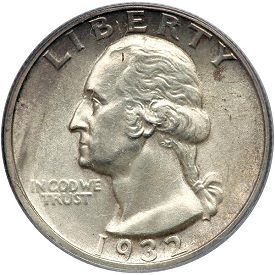 Currently, each silver Washington Quarter has a ‘melt value’ in the range of $6.15 to $6.35. (Silver bullion prices may change in the near future.) Widely accepted price guides, such as Numismedia.com, value many dates at $7.50 to $15 each in circulated grades. John Albanese asserts, however, that “many dealers at small coin shows and some owners of coin shops would charge much less than the price guides for circulated better date Washington Quarters. They are usually happy to sell coins to collectors who are assembling sets,” John declares. Albanese is the founder and president of the CAC.
Currently, each silver Washington Quarter has a ‘melt value’ in the range of $6.15 to $6.35. (Silver bullion prices may change in the near future.) Widely accepted price guides, such as Numismedia.com, value many dates at $7.50 to $15 each in circulated grades. John Albanese asserts, however, that “many dealers at small coin shows and some owners of coin shops would charge much less than the price guides for circulated better date Washington Quarters. They are usually happy to sell coins to collectors who are assembling sets,” John declares. Albanese is the founder and president of the CAC.
“Coin shops buy silver coins from the general public all the time, especially this year,” Albanese points out. The “shop owners do not have the time to look carefully at each coin. They have a constant flow of fresh silver coins that people are selling at bullion value. Many Coin shop owners will let collectors go through their quantities of silver coins. Etiquette is important,” John emphasizes.
“Be nice to your local dealers and they [may] let you buy silver coins for your collection for a little over melt. Collectors can often find better dates in silver bags.” Albanese suggests that “collectors buy albums and supplies from local dealers and [develop] relationships.”
Albanese also states that “most dealers probably do not bother to check 1950-D or 1950-S quarters for [over-mintmark] varieties. You may be able to get these for a little over melt, too. If you can’t, don’t worry, you do not need [such] varieties for a set of silver quarters.”
Price guides indicate that the 1950-D/S and the 1950-S/D over-mintmark varieties are relatively expensive, in contrast to other Washington Quarters from the 1950s. I agree with Albanese’s view that these are not needed for sets.
Some guides itemize ‘Light Motto,’ “Medium Motto’ and “Heavy Motto’ varieties for 1934 quarters, and 1934-D ‘Medium’ and “Heavy Motto’ varieties. In my opinion, it does not make sense for collectors assembling sets, especially beginners, to pay premiums for these. Albanese concurs. The differences are slight. For a ‘complete’ set of silver Washington Quarters, only one 1934 is needed, and only one 1934-D!
An experienced, knowledgeable collector who wishes to devote years and a lot of hours to specializing in Washington Quarters may wish to collect these by ‘die variety.’ This is a specialized undertaking that need not and should not concern most collectors. I suggest that most collectors of Washington Quarters do not purchase the ‘Motto’ varieties or the “Doubled Die” varieties of 1937 and 1942-D quarters. Theses varieties are barely noticeable.
So, if light and heavy mottoes, doubled dies, and over-mintmarks are ignored, as I contend they should be by most collectors, a set of silver Washington Quarters could be completed for $500 to $800. A persistent and lucky collector might be able to accomplish this feat for less than $500. If the 1932-D and the 1932-S are excluded, then an almost complete set could certainly be assembled for less than $500, maybe even less than $350!
For less than $1000, a set could be completed with numerous Extremely Fine to AU grade Washington Quarters. After a collector finishes a set of silver Washington Quarters ‘by date’ (including mintmarks), he or she may wish to add these two over-mintmark varieties for prices in the range of $20 to $300 each, depending upon each coin’s respective grade. As Albanese mentions, though, a collector may be able to discover these by carefully examining 1950-D and 1950-S quarters that have not been sorted. John suggests that most dealers will not take the time to inspect such coins.
For $1000 to $1250, a set of all silver Washington Quarters in Very Fine-20 or higher grades could be assembled, including retail prices for the two over-mintmark varieties. As Washington Quarters are not rare, someone who has a lot more money to spend would, from a logical perspective, find better values in pre-1917 U.S. silver coins.
III. Standing Liberty Quarters (SLQs)
A set of circulated SLQs is a little less expensive than a set of Barber Quarters, though much more expensive than a set of silver Washington Quarters. A 1916 SLQ in Good-04 grade may cost as much as $3000, certainly not less than $2000. A 1918/17-S overdate is likely to have a retail price above $1500. A Good-04 grade 1923-S, which might be barely identifiable, may be priced at $250 or more. If a collector is willing to forego these three dates, an almost complete set would not be expensive.
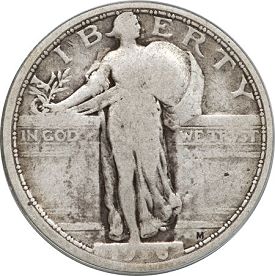 In Good grades, 1919-D and a 1919-S might each cost $70, a 1921 $160, and a 1927-S, $50. These values are just approximations. An appealing 1924-D is difficult to find in any grade range.
In Good grades, 1919-D and a 1919-S might each cost $70, a 1921 $160, and a 1927-S, $50. These values are just approximations. An appealing 1924-D is difficult to find in any grade range.
Regarding SLQs, “avoid Good and VGs,” Albanese recommends, “these have partial dates and are too worn. Start with Fine to Very Fine grade” SLQs. Similarly, Matt Kleinsteuber says, “don’t buy Good and Very Good [grade] coins. It is great for beginners to buy nice [naturally] toned, problem-free VF and Extremely Fine [SLQs] raw.” Coins that are not certified are ‘raw.’
Generally, Kleinsteuber maintains that SLQs are “beautiful and are much better values than Washington Quarters in all grades, especially certified MS-63 and MS-64 coins.” Matt is the lead grader and trader for NFC coins, and is an instructor at ANA grading seminars.
According to Kleinsteuber, except for the 1916 and the 1918/7-S, “buy them raw under AU-50 and put them in a book,” a coin album. When collectors buy SLQs that grade “AU-55 or higher, they should buy NGC or PCGS certified coins,” Matt asserts.
Albanese finds “Liberty Seated Quarters are better values than SLQs. I would rather have Barber Quarters, too.” I agree. SLQs are not very scarce and do not wear well. Their popularity has resulted in fairly high retail prices in comparison to other series of quarters.
Matt emphasizes the popularity of SLQs. He has “a real easy time selling Standing Liberty Quarters from AU-55 to MS-65; D & S Mints fly off the shelf.”
Albanese, Kleinsteuber and I all agree that collectors who buy MS-63 and higher grade SLQs should choose certified coins that are not designated as having a ‘Full Head,’ yet have considerable head detail. Albanese and I point out that market prices for SLQs in Fine to Very Fine grades are sensible.
An almost complete set of SLQs, missing a 1916 and a 1918/7-S overdate, in Fine-12 grade may cost around $2500. This amount would be for a set of thirty-seven coins, an average of more than $67.50 per coin. For collectors who like the aesthetics of SLQs in Fine grade, this option may be reasonable enough. Such an almost complete set in EF-40 grade would cost a lot more.
Collectors of SLQs should face the reality that the 1916 and the 1918/7-S each cost thousands. A type set of just three SLQs is more affordable for many non-affluent collectors, who may choose to complete a set of silver Washington Quarters.
IV. Liberty Seated Quarters
An intermediate level collector who has time, a few thousand dollars to spend over a period of years, and a passion for coins may consider collecting Liberty Seated Quarters. These are among my favorite series of U.S. coins. In my personal opinion, the Liberty Seated design looks wonderful on coins of this size and a little awkward on dollar size coins.
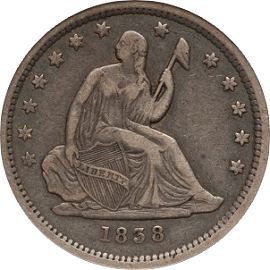 John Brush regards “the set” of Liberty Seated Quarters as being “underrated. They have been far less publicized than 20th century [quarter] issues and are far less available in semi-key and key dates.” Brush is the vice president of David Lawrence Rare Coins.
John Brush regards “the set” of Liberty Seated Quarters as being “underrated. They have been far less publicized than 20th century [quarter] issues and are far less available in semi-key and key dates.” Brush is the vice president of David Lawrence Rare Coins.
Albanese asserts that “there are loads and loads of good values for Very Fine to Extremely Fine Liberty Seated Quarters. You do not have to buy every coin [in the series] to have a collection. You could buy 90% of them for under $250 [each], choice never cleaned coins with natural toning.” As a particularly “good value,” Albanese suggests “a choice EF-45 1862 quarter, a Civil War [era] date, for $110.”
John Albanese mentions three Liberty Seated Quarters of famous subtypes in Very Fine grade as examples of excellent values. A collector could buy “in Very Fine, an 1838 No drapery Quarter for around $100, an 1854 [with] Arrows for $45, about the same price as a common date 1891 quarter, and an 1853 ‘Arrows & Rays’ for only a few dollars more.” The 1853 ‘Arrows & Rays’ is a famous one-year only type.
As there are fewer than seven known 1873-CC ‘No Arrows’ Liberty Seated Quarters, a set of Liberty Seated Quarters may be considered effectively complete without one. Unfortunately, the other Carson City issues of the early 1870s cost thousands of dollars. Almost the entire rest of the set, however, could be acquired for prices ranging from $20 to $500 per coin. It is less difficult to collect Liberty Seated Quarters than most collectors realize. A collector who is willing to spend an average of $750 per coin could assemble a fairly appealing, almost complete set of Liberty Seated Quarters!
V. Barber Quarters
I have been extremely enthusiastic about Barber coins since my grandmother gave me a few of all three denominations when I was five years old. Even so, Barber Quarters may not now be the best choice for beginning to intermediate level collectors of U.S. silver coins.
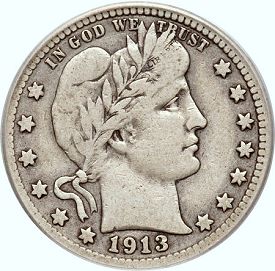 Last week, I wrote about collecting Barber Dimes and Barber Half Dollars. Earlier, I wrote a piece on dimes in general. A set of Barber Quarters is more difficult than a set of Barber Half Dollars. In circulated grades (below MS-60), each of the three key Barber Quarters is more expensive than any corresponding Barber Half Dollar. These key quarters are the 1896-S, the 1901-S and the 1913-S.
Last week, I wrote about collecting Barber Dimes and Barber Half Dollars. Earlier, I wrote a piece on dimes in general. A set of Barber Quarters is more difficult than a set of Barber Half Dollars. In circulated grades (below MS-60), each of the three key Barber Quarters is more expensive than any corresponding Barber Half Dollar. These key quarters are the 1896-S, the 1901-S and the 1913-S.
Any gradable 1901-S quarter costs thousands and a 1913-S quarter certainly costs more than $1000 in Good-04 grade. An 1896-S quarter is likely to cost several hundred dollars and its price rises to around $2000 in Fine-12 grade. Generally, sets of circulated Barber Dimes or Barber Halves are less expensive and may be better values for collectors on tight budgets.
Suppose, though, that a collector really likes Barber Quarters and is willing to ignore the 1896-S, the 1901-S and the 1913-S. An almost complete set would then cost less than $1000 in Good-04 grade, and less than $3000 in Fine-12 grade. An almost complete set in Very Fine or higher grades would cost considerably more.
Someone who is willing to spend thousands of dollars on an almost complete set of quarters would be better served by collecting Liberty Seated Quarters, a series in which exciting type coins and true rarities can be obtained for modest sums. The beginning collector of quarters who is on a very tight budget should probably opt for Washington Quarters or for a type set.
©2011 Greg Reynolds


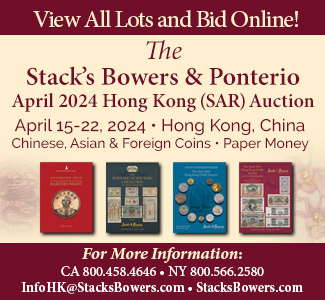


Where can I find a list of what years to look for on the bicentennial quarters and silver dimes. Does any state quarters have additional value including the 5 quarter mint sets from 2001,
Bicentennial quarters were produced from 1975-1976. They carry the date 1776-1976 on them. Only some examples are made of silver, they will carry the “S” mint mark, but that alone is not diagnostic. Silver dimes struck for circulation carry the date 1964 or earlier.
State quarters in as-issued condition carry a slight premium over their face value – but nothing significant at this time. The exception to this are conditionally rare examples or errors.